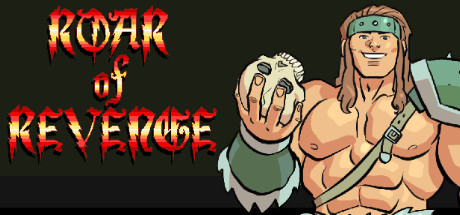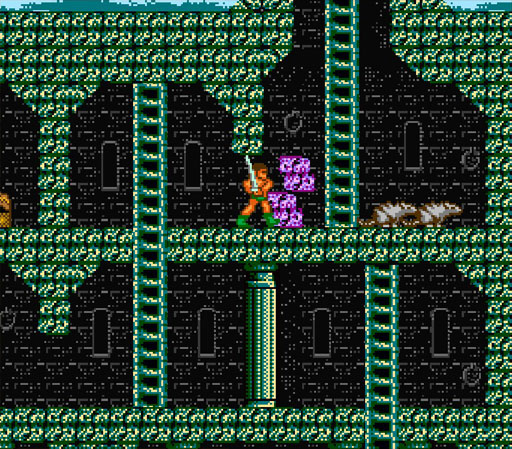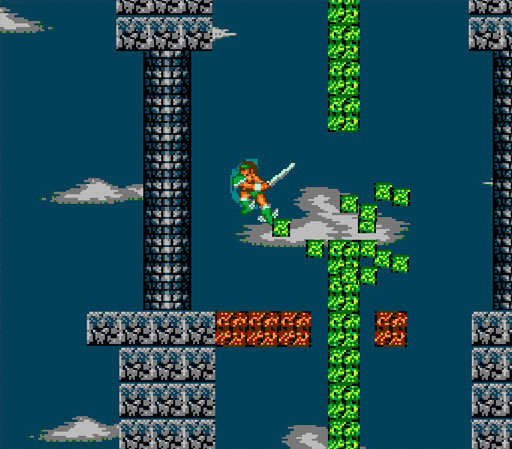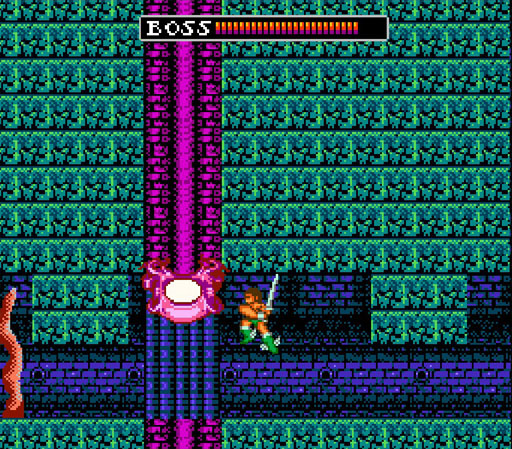A game by Seep for PC, originally released in 2021.
Roar of Revenge is a retro-style actioner set in a mythical world with a focus on sword-based combat, as inspired by games like Rastan and Faxanadu. You take on the role of Keel the Barbarian (no relation to Conan or Richard), the last survivor of his destroyed city. He sets out on a quest to stop Leomhann, the tyrannical man-lion who rules over the Kingdom of Arxaz, aided by three powerful titans that he summoned from ancient times.While Keel is a powerful warrior, his only hope of defeating these enemies lies in finding a series of powerful relics, each of which grants him new abilities. His journey takes him to every corner of the land as he explores caverns and forests, catacombs and temples, and even cloudy skies and the depths of the sea. On his journey, he encounters a few allies who aid him in his quest, but the landscape is populated with dark creatures who attempt to thwart him at every turn.
At the start of the game, you only have the ability to walk, duck, climb ladders, and swing your sword to the left or right while standing or ducking, with all other abilities unlocked as you encounter each of the relics. While ducking, your rate of attack is reduced, so it’s best to stand and fight unless you’re attempting to avoid projectiles. It’s also worth noting that if you don’t press UP or DOWN when approaching a ladder, you will fall straight down, which is unlike other games where you would typically be able to walk straight across a platform that intersects a ladder.
Throughout your adventures, you gain a 1x nonvariable jump, a magic projectile, and a dash maneuver. The dash can be used on the ground or in the air and it’s capable of wiping out multiple enemies, but you have no control during this time, and the move has a long duration. It also has an incredibly long cooldown period, making it most useful to get out of tough situations quickly, or to smash your way through a crowd of oncoming enemies.
The magic projectile has limited ammo, offering only six shots that are restored between levels. But these shots are very powerful, making quick work of enemies that would otherwise take multiple sword strikes to destroy. They can also wear down boss health meters quickly, and as such are best kept in reserve for use against the most threatening foes. Only by mastering the sword can you hope to make any progress.
There are a few items to collect along the way, including keys, purple rings, and diamonds, all of which act as keys to bypass gates, magic blocks, and other barricades. On occasion, the way forward can only be opened by defeating one or more powerful enemies. Later in the game, there are hourglasses that temporarily grant infinite magic projectiles, which are needed to fight ghosts, as well as infinite dash maneuvers, which are needed to complete a series of platforming challenges over bottomless pits.
Early on, most creatures die with a single strike of your sword, but enemies grow ever more powerful and numerous as the adventure wears on. There are lots of flying enemies that are mainly in place to pester you as you decide whether to fight or avoid them. There are a small number of projectile-firing enemies which can be tough to deal with given your limited attack range. And there are several major enemies that require numerous hits to kill, which are usually presented as 1-on-1 fights rather than being mixed in with regular foes. Stone golems are particularly tough, requiring you to deliver strikes, avoid laser beams from their eyes, and then get onto a ladder to drop behind them and finish them off.
There are several boss encounters as well, but these tend to be quite simple, and often quite easy. The first encounter takes the form of a cacodemon-esque creature that attacks you on its own. When killed, it summons two more such creatures, and these split when attacked, leaving you to face four of them at once. But they mostly bounce harmlessly around the top of the room, occasionally moving toward the ground for you to get in a hit or two. All of them share a single life bar, so you can hit any of them to bring the battle to an end.
The next boss is a bit of a fakeout, where you seemingly face off against a super easy stationary foe that occasionally drops slow-moving worms. But when you defeat it and leave the area, you enter another room with a palette-swapped version of that enemy who uses different attacks (which are still pretty easy to avoid). Defeating that boss reveals yet another room with a boss fight against a third iteration of the creature, but now it drops projectile-firing worms that take three hits to destroy, making for a much more difficult encounter. Getting killed in any of these rooms sends you back to the first to do it all over again.
Most bosses can be defeated through attrition with players finding a reasonably safe spot from which to mash the ATTACK button over and over again while dodging the occasional projectile, and players who enter boss battles with a full complement of magic projectiles can lop a big chunk off the boss’ life meter in the first few seconds of any fight. Boss patterns tend to be simple, and skilled players can expect to defeat most of them in in a small number of attempts… or even on their first try.
The player has a substantial life bar, but powerful strikes can drain several units in a single hit. Enemies do not drop restoratives of any kind, so the player’s health is only restored at checkpoints, which are represented by weapon racks. These checkpoints can be spread out quite far, leading to a lot of repeated gameplay if the player is killed, but the player has infinite lives and can reload directly to the latest checkpoint from the title screen.
In addition, the game features several insta-kill traps and bottomless pits – often interspersed with enemies – so players must use caution to avoid a swift end. Fortunately the player is not knocked back when hit, so this helps him to avoid cheap deaths when fighting enemies during platforming sequences. The game offers five different endings depending on how many times the player is killed, with a death indicator appearing in the lower right corner. The best ending comes with 10 or fewer deaths, while the worst appears after 70 or more deaths.
There are a few places where the gameplay is changed up from the typical jumping and swordplay. These come in the form of some less linear exploration areas, two vertical scrolling sequences (although these are quite simple), and a lengthy underwater area where you explore and fight enemies while swimming.
There is a narrative framework here, with numerous story sequences appearing between levels, when interacting with the occasional NPC. As is typical of the genre, the player may skip through these text boxes and still have a pretty solid understanding of what’s happening. The game also features some nice level transitions with a view of the world map, showing an overview of all the areas. The game is presented with an 8-bit style and chiptune soundtrack meant to evoke the aesthetics of the NES.
2D CRED
Roar of Revenge was developed by Seep, a studio based in Turin, Italy and founded in 2015 by brothers Sergio and Enrico Giansoldati. The studio focuses on retro-style games, with releases including Adventure Bit, Swords & Bones, SEEP Universe, Abduction Bit, Dragon Climax, Super Boo Quest, Katana Soul, and Thunderflash. The game includes artwork from Oscar Celestini and music composed by Stennish.


























2 comments:
Roar of revenge is one of the types of indie games that I like the most. It perfectly fulfills the task of remembering those NES games like Battle of Olympus, Faxanadu etc...
The only drawback I could put is the music, it's too short and repetitive.
The graphics are very simple but that's how they were normally on the NES for this type of game, Battle of Olympus or Zelda II don't have much better graphics than Roar of revenge.
I don't know how it is doing in terms of units sold, but I would like this type of game developed by 2 people (with very specific collaborations, for example for music) to have good sales, at least to be able to continue developing similar games. Another thing is the games called "clone games", they are not to my taste, but Roar of revenge is not one of them.
The developer seems to be doing pretty well, with numerous releases over the past two years, and many multiplatform games among them. They're definitely serving a niche audience, but hopefully that audience remains receptive to their retro style.
Post a Comment